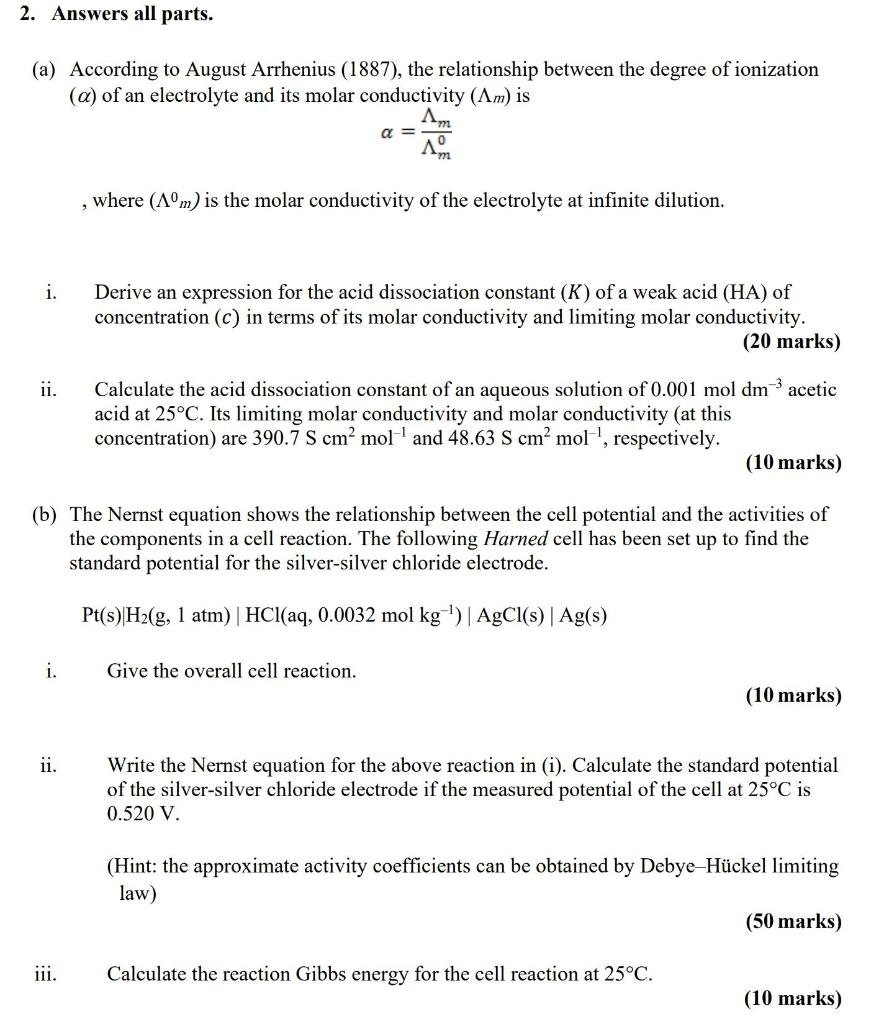Home /
Expert Answers /
Chemistry /
2-answers-all-parts-a-according-to-august-arrhenius-1887-the-relationship-between-the-degre-pa476
(Solved): 2. Answers all parts. (a) According to August Arrhenius (1887), the relationship between the degre ...
2. Answers all parts. (a) According to August Arrhenius (1887), the relationship between the degree of ionization \( (\alpha) \) of an electrolyte and its molar conductivity \( \left(\Lambda_{m}\right) \) is \[ \alpha=\frac{\Lambda_{m}}{\Lambda_{m}^{0}} \] , where \( \left(\Lambda^{0} \mathrm{~m}\right) \) is the molar conductivity of the electrolyte at infinite dilution. i. Derive an expression for the acid dissociation constant \( (K) \) of a weak acid (HA) of concentration \( (c) \) in terms of its molar conductivity and limiting molar conductivity. (20 marks) ii. Calculate the acid dissociation constant of an aqueous solution of \( 0.001 \mathrm{~mol} \mathrm{dm}^{-3} \) acetic acid at \( 25^{\circ} \mathrm{C} \). Its limiting molar conductivity and molar conductivity (at this concentration) are \( 390.7 \mathrm{~S} \mathrm{~cm}^{2} \mathrm{~mol}^{-1} \) and \( 48.63 \mathrm{~S} \mathrm{~cm}^{2} \mathrm{~mol}^{-1} \), respectively. (10 marks) (b) The Nernst equation shows the relationship between the cell potential and the activities of the components in a cell reaction. The following Harned cell has been set up to find the standard potential for the silver-silver chloride electrode. \( \mathrm{Pt}(\mathrm{s})\left|\mathrm{H}_{2}(\mathrm{~g}, 1 \mathrm{~atm})\right| \mathrm{HCl}\left(\mathrm{aq}, 0.0032 \mathrm{~mol} \mathrm{~kg}^{-1}\right)|\mathrm{AgCl}(\mathrm{s})| \mathrm{Ag}(\mathrm{s}) \) i. Give the overall cell reaction. (10 marks) ii. Write the Nernst equation for the above reaction in (i). Calculate the standard potential of the silver-silver chloride electrode if the measured potential of the cell at \( 25^{\circ} \mathrm{C} \) is \( 0.520 \mathrm{~V} \). (Hint: the approximate activity coefficients can be obtained by Debye-Hückel limiting law) (50 marks) iii. Calculate the reaction Gibbs energy for the cell reaction at \( 25^{\circ} \mathrm{C} \).
Expert Answer
The objective of the question is to: (a) (i) Derive an expression for acid dissociation for a weak acid in terms of molar and limiting molar conductiv
